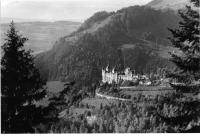Out of all this came the idea that a special planeload of seventy-six, the most representative group to leave Japan since the war, should go to Caux in the summer of 1950. General Douglas MacArthur, the US supremo in Japan, warmly endorsed the venture, and one June evening the DC-4 lifted off over a moonlit Tokyo Bay, taking a delegation which included Members of Parliament from all the main parties, seven Governors of Prefectures, the Mayors of Hiroshima and Nagasaki, and leaders of industry, finance and labour. Prime Minister Yoshida offered them a vivid conception of their mission at a luncheon for leaders of the delegation. 'In 1870', he said, 'a group of Japanese travelled to the West. On their return they changed the course of Japanese life. I believe that when this delegation returns you too will open a new page in our history.'8
The Japanese arrived at Caux full of apprehension about how they would be received by the people from many countries, including recent enemies. Buchman had anticipated their fears. He was at the door of Mountain House to greet each one personally, and had made sure that the Japanese flag was flying alongside those of the other nations. Under American occupation the flag could not be flown, and at the sight of it tears came to the visitors' eyes.

Buchman also took care to observe the niceties of Japanese manners - bowing instead of shaking hands, paying attention to their rules of seniority, and providing them with Japanese food perfectly cooked. One of the labour leaders in the party, Daiji Ioka, chairman of the Municipal Workers of Osaka, told the assembly, 'Our nation took a road to war which has caused tremendous suffering to the world. When my colleagues and I left Tokyo we fully expected to be treated as enemies, even to the point of segregation, but we were overwhelmed by the warmth of the welcome we received.'9
During their stay Buchman planned the meetings so that they heard French and Germans promising to rebuild a ruined Europe together, management and labour undertaking to help industry to meet the needs of people, and rival political leaders seeking ways to unite their countries. He met with the delegation and with individuals privately, alert to draw out their aspirations and reinforce their new decisions. Such decisions were numerous. For example, the Governor of Nagano province and the Mayor of its capital publicly forsook their well-known antagonism to each other; and a militant labour leader, Katsuji Nakajima, and his 'public enemy number one', the regional police chief, Eiji Suzuki, were reconciled.
389
Photo: Mountain House, Caux, Switzerland. Part of the conference centre opened by Swiss friends as a base for Buchman's post-war work in Europe. It rapidly became a world centre.
©Michael Blundell/MRA Productions